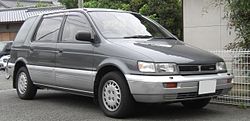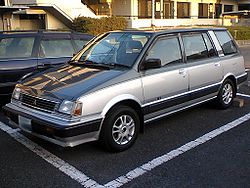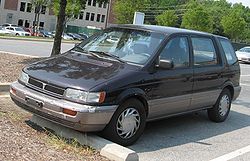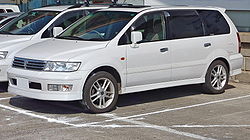- Mitsubishi Chariot
-
Mitsubishi Chariot 
Manufacturer Mitsubishi Motors Production 1983–2003 Successor Mitsubishi Grandis[1] Class Compact MPV Body style 5-door minivan The Mitsubishi Chariot, is a five door, five/seven seat compact MPV produced by Mitsubishi Motors of Japan from 1983 to 2003. It was based on the SSW concept car first exhibited at the 23rd Tokyo Motor Show in 1979,[2] and named for the battle chariots used during the times of the ancient Greek and Roman Empires.[3] Internationally, it has been sold under various names, including Mitsubishi Space Wagon, Mitsubishi Nimbus and Mitsubishi Expo. The Chariot has been sold as the Dodge/Plymouth Colt Vista Wagon captive imports in North America, and as the Eagle Vista Wagon in Canada, and has also been manufactured under license as the Hyundai/Galloper Santamo and Mitsubishi Savrin in Asia.
Contents
First generation (1983–1991)
First generation 
Also called Mitsubishi Nimbus (Aus)
Mitsubishi Space Wagon
Dodge/Plymouth Colt Vista
Eagle Vista Wagon (Canada)Production 1983–1991 Assembly Okazaki, Aichi, Japan
Porirua, New ZealandLayout Front engine,
front-/four-wheel driveEngine 1,597 cc G32B I4 (D02W)
1,755 cc G37B I4 (D05W)
1,795 cc G62B I4 (D03W)
1,997 cc G63B I4 (D08W)
1,795 cc D65T I4 turbodiesel (D09W)Transmission 3-speed automatic
5-speed manualWheelbase 2,625mm Length 4,490mm Width 1,645mm Height 1,525mm The first generation of Chariot (D0#W-series) was produced from February 1983 to May 1991 with a choice of SOHC straight-4 powerplants ranging from the 1.6-liter 4G32 to the 2.0-liter 4G63 petrol engines, or the 1.8 liter 4D65T turbodiesel (from October 1984), mated to a five-speed manual or three-speed automatic transmission.[4] It occupied the market segment previously served by the Mitsubishi Galant station wagon.
The Chariot's wheelbase was 2,625 millimetres (103.3 in), while overall length ranged from 4,295–4,485 millimetres (169.1–176.6 in) depending on market and equipment level, which was within compliance with Japanese regulations concerning exterior dimensions and engine displacement size. From June 1984, a version with permanent four-wheel drive was also offered,[4] while Japanese customers could also get the 4G62T engine in the MR Turbo version from July 1983 until the 1987 model year (1,795 cc, 135 PS/99 kW at 5,800 rpm).[5] This version could reach 175 km/h (109 mph), and was also available with the 3-speed automatic.[6]
In Australia, where it was marketed as the "Nimbus", it won the 1984 Wheels Car of the Year award in its debut year.[7] The Nimbus model codes were "UA" (1984), "UB" (1986), and "UC" (1987).
A single 1.8-litre GLX version, with manual or automatic transmission was assembled from CKD kits in New Zealand by importer Todd Motors (later Mitsubishi NZ Ltd).[citation needed]
The rebadged Dodge and Plymouth Colt Vista, or in Canada, the Eagle Vista Wagon, were introduced in 1983 as a 1984 model. Slotted below the Dodge Caravan and Plymouth Voyager as Dodge/Plymouth's entry-level minivans, they were offered in North America until 1991. The Colt Vista was available with the 2.0-liter 4G63, producing 98 horsepower (73 kW) in US trim, and either front-wheel drive or permanent four-wheel drive. Top speed was 155 km/h (96 mph), 150 km/h (93 mph) for the 4WD.[8]
Second generation (UF; 1991–1997)
Second generation 
Also called Hyundai Santamo
Mitsubishi Expo
Mitsubishi Nimbus
Mitsubishi Space WagonProduction 1991–1997 Assembly Okazaki, Aichi, Japan
Porirua, New ZealandLayout Front engine,
front-/four-wheel driveEngine 1997 cc I4
2350 cc I4 (USA)Transmission 5-speed manual
4-speed automaticWheelbase 2,720mm Length 4,515-4,555mm Width 1,695mm Height 1,580-1,670mm Related Mitsubishi RVR The second generation, from 1991 to 1997, was enlarged in every dimension, offering a longer wheelbase, and greater length, width, and height, while still remaining in the Japanese Governments regulations concerning vehicle exter dimensions and engine displacement. It retained the 4G63B engine, but phased out the 4G37B and replaced the old turbodiesel with a with a newer 1997 cc 4D68T powerplant, and in 1993 a 2350 cc 4G64 was added to the range. A five-speed manual, or four-speed auto could be specified, and in high-end models an INVECS electronically controlled 4-speed auto with "fuzzy logic" was also available.
It continued the previous seating arrangement of three rows of seats, capable of seating seven people. The middle row can be slid forward or back to accommodate multiple seating arrangements. The second and third row have solid bench seat cushions with seat backs that are split 50:50; the second row seatbacks can be both folded down upon the seat cushions or reclined completely flat with the third row seat cushion. The second row can also be slid forward to provide access to the third row.
Again, from 1992, a single GLX model was assembled in New Zealand, with manual or automatic transmissions, at Mitsubishi's Porirua plant. According to the corresponding article on Korean Wikipedia, the Hyundai Santamo name was an acronym, meaning "SAfety aNd TAlented MOtor". Due to the partnership that existed between Chrysler Motors and Mitsubishi Motors during this time period, this generation of Chariot shares a similar appearance with the sales leader Dodge Caravan and Plymouth Voyager, and was sold in North America as the Mitsubishi Expo. Mitsubishi's decision to offer a MPV instead of an SUV was also shared with the Mazda MPV without the increased ground clearance. This vehicle was also sold with a reduced length vehicle, known as the Mitsubishi RVR.
Third generation (UG; 1997–2003)
Third generation 
Also called Mitsubishi Nimbus
Mitsubishi Space WagonProduction 1997–2003 Assembly Okazaki, Aichi, Japan Layout Front engine,
front-/four-wheel driveEngine 2.4 L 4G64 engine, 3.0 L 6G72 V6 Transmission 4-speed semi-automatic Wheelbase 2,780mm Length 4,650mm Width 1,775-1,780mm Height 1,650mm Related Mitsubishi RVR The third and final generation was introduced on October 17, 1997,[3] and was larger and heavier again. It was now known in its home market as the Chariot Grandis, after the French grandiose, to emphasise the increase in the car's size and quality as it moved from a ladder frame to monocoque construction,[7] using the company's RISE safety body.[3] Mitsubishi discontinued all other straight-4 engines in favour of a single gasoline direct injection version of the 4G64, while introducing a new 2972 cc SOHC 6G72 V6 powerplant, also GDI-equipped. The INVECS-II four-speed semi-auto became the only transmission option.[3] Due to the engine size exceeding 2000cc, and the width exceeding 1.7 m, this generation was no longer in compliance with Japanese regulations, and buyers were now liable for additional yearly taxes, which affected sales. This generation was not sold in North America, as the Plymouth Voyager and Dodge Caravan were now sold in regular and extended length vehicles, with the longer models sold as "Grand Caravan" and "Grand Voyager" in addition to the Chrysler Town and Country.
The Chariot Grandis was finally superseded by release of the Mitsubishi Grandis on May 14, 2003,[1] although production of the older vehicle continued until the following year for overseas markets.[9]
Production and sales
Year Production Sales Domestic Export 1995 41,943 figures unavailable 1996 33,648 1997 59,448 1998 88,251 1999 63,010 2000 26,734 22,821 10,092 2001 15,907 10,472 7,018 2002 10,595 3,724 7,310 2003 4,043 49 4,536 2004 138 - 208 (Sources: Fact & Figures 2000, Fact & Figures 2005, Mitsubishi Motors website)
References
- ^ a b "Mitsubishi Motors Releases New Grandis", Mitsubishi Motors press release, May 14, 2003
- ^ "The 23rd Tokyo Motor Show". Japan Automobile Manufacturers Association (JAMA). http://www.tokyo-motorshow.com/eng/show/history/history_23.html.
- ^ a b c d "Mitsubishi Motors Launches Chariot Grandis New-generation SUV", Mitsubishi Motors press release, October 13, 1997
- ^ a b (in Japanese) Car Graphic: Car Archives Vol. 11, '80s Japanese Cars. Tokyo: Nigensha. 2007. p. 216. ISBN 978-4-544-91018-6.
- ^ Auto Katalog 1987. Stuttgart: Vereinigte Motor-Verlage GmbH & Co. KG. 1986. pp. 238–239.
- ^ World Cars 1985. Pelham, NY: The Automobile Club of Italy/Herald Books. 1985. pp. 361–362. ISBN 0-910714-17-7.
- ^ a b "Used Car Review - Mitsubishi Nimbus 1984-2002", Bruce Newton, drive.com.au, May 10, 2005
- ^ Mastrostefano, Raffaele, ed (1990) (in Italian). Quattroruote: Tutte le Auto del Mondo 1990. Milano: Editoriale Domus S.p.A. p. 194.
- ^ Fact & Figures 2005, Mitsubishi Motors website
Mitsubishi Motors North America timeline Type 1980s 1990s 2000s 2010s 0 1 2 3 4 5 6 7 8 9 0 1 2 3 4 5 6 7 8 9 0 1 2 3 4 5 6 7 8 9 0 1 Subcompact Cordia Tredia Mirage Mirage Mirage Precis Compact Mirage Lancer Lancer Galant Galant Sigma Galant Diamante Sport compact Eclipse Eclipse Eclipse Eclipse Lancer Evolution Lancer Evolution Mid-size Galant Galant Diamante Diamante Sports car Starion 3000GT Station wagon Space Wagon Expo Expo LRV Compact XUV Outlander Outlander Outlander Sport/RVR Mid-size XUV Endeavor Minivan Vanwagon Sport utility vehicle Montero Sport Montero Montero Montero Pickup Mighty Max Mighty Max Raider Type 1980s 1990s 8 9 0 1 2 3 4 5 6 7 8 Subcompact Summit Summit Vista Compact Medallion 2000GTX Full-size Premier Vision Sports car Talon Talon Crossover Eagle wagon Eagle Vista wagon Eagle Summit Wagon Categories:- Mitsubishi Motors vehicles
- Compact MPVs
- Front wheel drive vehicles
- All wheel drive vehicles
- Vehicles introduced in 1983
Wikimedia Foundation. 2010.







